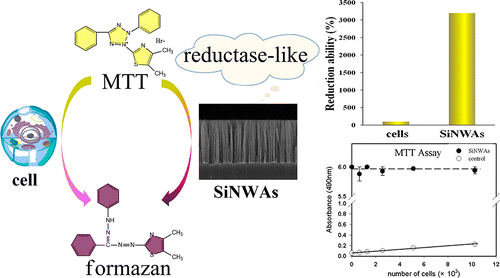Reductase-like Activity of Silicon Nanowire Arrays
Hongwei Wang , Wenwen Jiang , Lin Yuan *(袁琳), Lei Wang , and Hong Chen * (陈红)
Jiangsu Key Laboratory of Advanced Functional Polymer Design and Application, Department of Polymer Science and Engineering, College of Chemistry, Chemical Engineering and Materials Science, Soochow University, 199 Ren’ai Road, Suzhou, 215123, P. R. China
ACS Appl. Mater. Interfaces 2013, 5, 1800–1805.
The MTT (3-(4,5-dimethyl-2-thiazol)-2,5-diphenyl-2H-tetrazolium bromide) reduction method is widely used for measuring cell viability and proliferation. However, when MTT was used to study cells on silicon nanowire arrays (SiNWAs), the measured viability was much higher than normal values, resulting in a misleading estimate of cell viability. Our results demonstrated that the apparent high viability of cells is due to the fact that the SiNWAs itself was capable of reducing MTT in the absence of cells. In the presence of coenzyme, its reducing capacity was enhanced, thus showing the reductase-like function of SiNWAs. Furthermore, the chemical composition and nanostructure of Si surface had a strong influence on MTT reduction with the HF-treated SiNWAs (H-SiNWAs) showing significant reducing capacity. For example, the reduction capacity of H-SiNWAs samples was significantly higher than that of HF-treated planar silicon, whereas Piranha-treated SiNWAs and planar silicon did not reduce MTT. H-SiNWAs were also used for the reduction of azo dyes and showed a decolorization rate of more than 65% and as high as 90%. These findings suggest the potential use of SiNWAs as enzyme-mimics in biotechnology and environmental chemistry.

链接: //pubs.acs.org/doi/abs/10.1021/am3031322